The Milanese company Rizzoli & C. in Milan was one of the most prominent Italian publishers of film star postcards between 1936 and 1942. Through the years, Ivo Blom collected many of the wonderful Rizzoli cards with their glamorous portraits of famous actresses. In a series of posts, Ivo chooses his favourite Rizzoli cards and describes what happened in Italy in this turbulent period. This final post is about the last years of the series, 1941 and 1942. In the following years, the Italian film industry collapsed.

Italian postcard by Rizzoli & C., Milano, 1941. Photo: Venturini.
Isa Miranda (1905–1982) was the only international film star produced by the Italian fascist cinema. In Hollywood, she was billed as the ‘Italian Marlene Dietrich’ and played femme fatale roles. Later she became one of the most significant European film actresses during the 1940s and early 1950s. Among her films were Senza cielo/Without the Sky (Alfredo Guarini, 1940) opposite Fosco Giachetti, and Malombra (Mario Soldati, 1942) with Andrea Checchi.
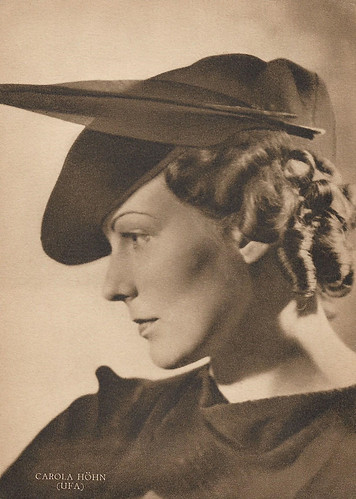
Italian postcard by Rizzoli & C. Milano, 1941. Photo: Ufa.
German actress Carola Höhn (1910-2005) had a 60 years lasting film career. She began as the elegant star of many Ufa productions and later became the acclaimed Grande Dame of the German post-war cinema. In 1941 Höhn starred in the Italian period piece Beatrice Cenci (Guido Brignone, 1941).
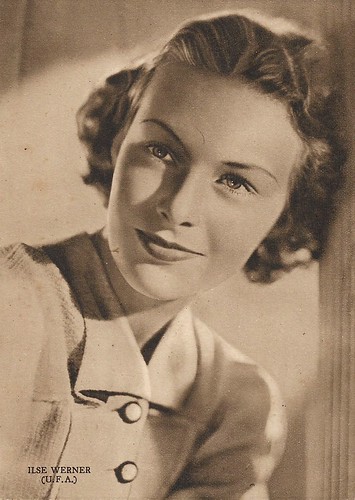
Italian postcard by Rizzoli & C., Milano, 1941. Photo: Ufa.
Dutch-born actress and singer Ilse Werner (1921-2005) was one of the most popular stars of the German screen during the Nazi years. She had her breakthrough with Wunschkonzert (Eduard von Borsody, 1940). Werner confirmed her reputation and popularity with the Jenny Lind biopic Die schwedische Nachtigall (Peter Paul Brauer, 1941). Her nickname, 'Ein Frau mit Pfiff', translates as 'A Woman of Distinction', but also refers to her trademark, whistling. After the war, she became a successful Schlager singer.
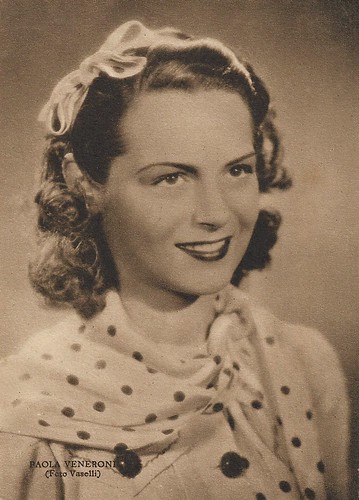
Italian postcard by Rizzoli & C., Milano, 1941. Photo: Vaselli.
Italian actress Paola Veneroni (1922) debuted as the spying pupil in Vittorio De Sica's Maddalena, zero in condotta (1940), starring Carla Del Poggio. Although it was her first film part, she immediately made an impact. With Del Poggio and Nina Paoli, she was the protagonist of Signorinette (Luigi Zampa, 1942), on three girls of 15-16 years old. After this film, she mostly played supporting parts.
After the Italians had been driven out of Egypt and the Eastern part of Libya, a large Germany army led by Erwin Rommel, the Afrika Korps, came the Italians to aid in early 1941, the start of the German African Campaign.
On the Balkan, Germany and Italy invaded Yugoslavia in April 1941 and struck a new battle with Greece, conquering the Greek mainland by the end of April, and Crete in May 1941. Italy gained southern Slovenia, Dalmatia, Montenegro and established the puppet states of Croatia and Hellenic State.
However, by 1942 the Italian economy was drastically going down, while Italian cities were being bombed by the Allies. Also, the African campaign was worsening – decisive defeat came with the Battle of El Alamein (October-November 1942).
It coincided with the French Invasion in North Africa and the Battle of Stalingrad. By January 1943 half of the Italian forces fighting in the Soviet Union were killed, the Balkan remained unstable, and Italians wanted to end the war.
In May 1943 the German and Italian forces in Africa would capitulate and in July 1943 the Allied forces would land in Sicily.
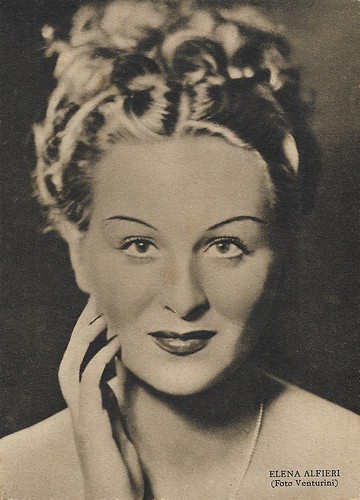
Italian postcard by Rizzoli & C., Milano, 1941. Photo: Venturini. Altieri's last name is misspelled on this card.
Italian film and stage actress Elena Altieri (1916–1997) appeared in 27 films between 1937 and 1955 and was mainly cast, both on stage and in films, in roles of haughty and aristocratic women. Altieri had major parts as 'the other woman' in Il pozzo dei miracoli (Gennaro Righelli, 1941) with Vivi Gioi and Antonio Centa, and Colpo di timone (Gennaro Righelli, 1942) with Gino Cervi and Dina Sassoli.
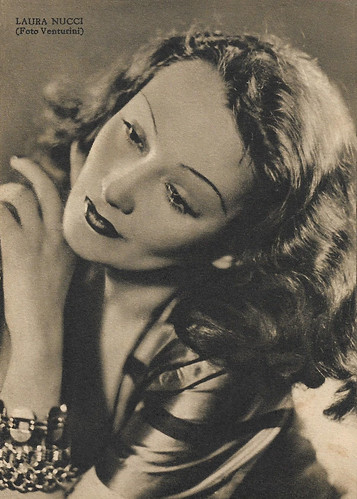
Italian postcard by Rizzoli & C., Milano, 1941. Photo: Venturini.
Italian actress Laura Nucci (1913-1994) was one of the stars of Italian cinema of the 1930s and 1940s. She also starred in the adventure film Fra' Diavolo/The Adventures of Fra Diavolo (Luigi Zampa, 1942) opposite Enzo Fiermonte. During the German occupation of Rome in 1943-1944, Laura Nucci became a close friend of Erich Priebke, the captain of the Gestapo. Between 1930 and 1989, she appeared in more than 60 films and TV series.

Italian postcard by Rizzoli & C., Milano, 1941. Photo: Venturini.
The elegant brunette Vanna Vanni (1920-1998) was an Italian film actress who peaked in the late 1930s and early 1940s. She mostly played in comedies, many directed by Gennaro Righelli, plus several with the De Filippo family. Occasionally she also acted in dramas such as Amiamoci così (Giorgio SImonelli, 1940) with Andrea Checchi.

Italian postcard by Rizzoli & C., Milano, 1941. Photo: Cie Française Cinem.
French actress and opera singer Renée Saint-Cyr (1907-2004) starred in more than 30 comedies and romantic dramas between 1932 and 1943. In 1940 she went to Italy to play opposite Vittorio De Sica in his own film Rose scarlatte (Vittorio De Sica, 1940), based on a play by Aldo de Benedetti. The photo on this card may stem from that experience. After the war the alluring beauty continued her film career in supporting roles, usually playing chic ladies.
Despite the war and all the obstacles that came with it, the Italian film industry was highly active in the years 1941-1942. It would only collapse in 1943-1944.
Of course, Italy, with the entering into the war, produced several propaganda films, in addition to the documentaries, shorts, and newsreels, also fiction films lauded the Italian war campaigns, resulting in films such as Bengasi (Augusto Genina, 1942), Gente dell'aria (Esodo Pratelli, 1943), and I tre aquilotti (Mario Mattoli, 1942, based on a script by Vittorio Mussolini), etc.
Notable for its documentary-like approach was the submarine film Uomini sul fondo (1941) by Francesco De Robertis, while Roberto Rossellini did a war trilogy in which he combined propaganda with an anti-spectacular approach which he would continue which after the war as well: La nave bianca (1941), Un pilota ritorna (1942) and L'uomo dalla croce (1943).
A remarkable success was the two-part, anti-communist dark melodrama Noi vivi/Addio Kira!/We the living (Goffredo Alessandrini, 1942), inspired by a novel by Ayn Rand, and starring Alida Valli, Rossano Brazzi, and Fosco Giachetti.
Preceding the postwar neorealist cinema (and Luchino Visconti’s 1943 milestone Ossessione) but also reminding of the late 1930s French Poetic Realism is the social drama Fari nella nebbia (Gianni Franciolini, 1942) with Fosco Giachetti, Luisa Ferida and Mariella Lotti.
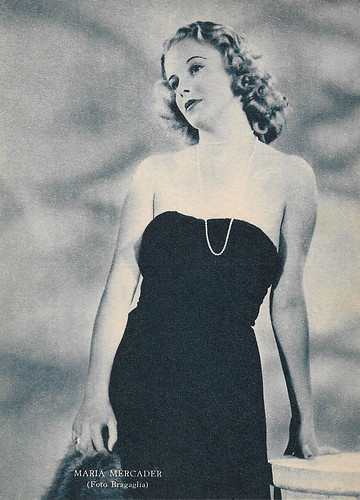
Italian postcard by Rizzoli & C., Milano, 1942. Photo: Bragaglia.
María Mercader (1918-2011) was a Spanish actress who acted in Spanish and Italian films, largely between 1939 and 1952. She was the second wife of Vittorio De Sica and the mother of Christian and Manuel De Sica.
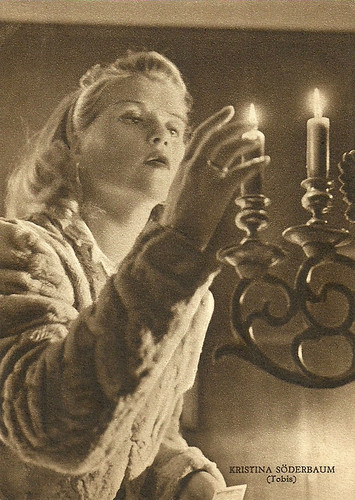
Italian postcard by Rizzoli & C., Milano, 1941. Photo: Tobis.
Swedish-born, German film actress Kristina Söderbaum (1912-2001) was considered the prototype of an Aryan woman during the Third Reich. The blonde, blue-eyed star played the lead in several Nazi propaganda films directed by her husband Veit Harlan. After the war, this would damage her career.
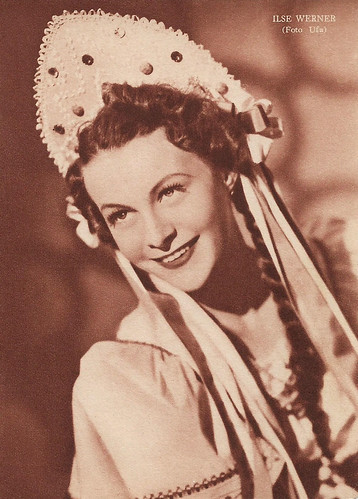
Italian postcard by Rizzoli & C., Milano, 1942. Photo: UFA.
Dutch-born actress and singer Ilse Werner (1921-2005) was one of the most popular stars of the German screen during the Nazi years. In 1942, she starred in the popular backstage musical Wir machen Musik/We're Making Music (Helmut Käutner, 1942) with Viktor de Kowa.

Italian postcard by Rizzoli & C., Milano, 1942. Photo: Pesce. Annette Bach in Il mercante di schiave/Merchant of Slaves (Duilio Coletti, 1942).
German actress Annette Bach moved to Italy after a small part in Jud Süss/Jew Süss (Veit Harlan, 1940). In 1942, she starred in the Italian films Labbra serrate/Lips tightened (Mario Mattoli, 1942) and Il mercante di schiave/Merchant of Slaves (Duilio Coletti, 1942).
During the early war years, a new generation of young actors and actresses debuted in Italian cinema, such as Carla Del Poggio, Irasema Dilian, Luisella Beghi, Lilia Silvi, Elsa Altieri, Paola Veneroni, and others, mostly acting in romantic dramas or light comedies.
Comedy remained a large share of the overall production. Also, Vittorio De Sica, who had been so popular in the Camerini comedies, now started to direct his own films, often with a stronger social comment.
In contrast to the comedies and the propaganda films stood a string of literary adaptations, in which the inner conflicts and psychology of the main characters were central, combined with elaborate settings.
In hindsight, initially, the pejorative term Calligraphism was attached to this, but from the sixties on these films were highly revaluated. Thus Mario Soldati directed Alida Valli in Piccolo mondo antico (1941) and Isa Miranda in Malombra (1942).
Other directors within his genre were Luigi Chiarini, Alberto Lattuada, Renato Castellani a.o. Camerini had its most successful example of 1941-1942 with his adaptation of Manzoni’s I promessi sposi/The Spirit and the Flesh (Mario Camerini, 1941), starring Gino Cervi, Dina Sassoli, and Enrico Glori.
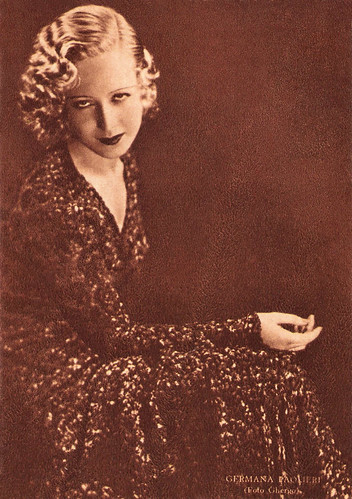
Italian postcard by Rizzoli & C., Milano, 1942. Photo: Ghergo.
Germana Paolieri (1906-1998) was an Italian stage and screen actress. After the war, she also worked for radio and television. As an actress, she flourished between the early 1930s and 1981, while as film actress she peaked in the 1930s and early 1940s, but also the mid-1950s. She acted in La gerla di papà Martin (Mario Bonnard, 1940) with Ruggero Ruggeri, Se son matti non li vogliamo (Esodo Pratelli, 1941) again starring Ruggeri, and in particular in the historical melodrama Pia de' Tolomei (Esodo Pratelli, 1941) in which Paolieri played the title role. During the war years, she also had a supporting act as Lauretta in Veit Harlan’s extremely romantic film Immensee/Il perduto amore (1943), starring Carl Raddatz and Kristina Söderbaum.
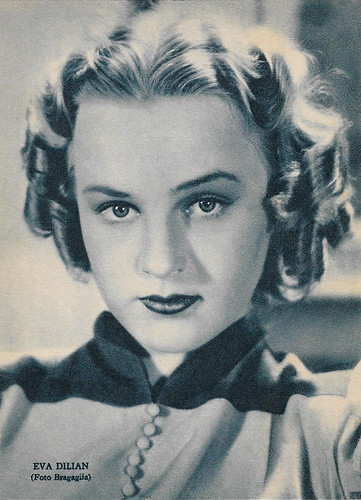
Italian postcard by Rizzoli & C., Milano, 1942. Photo: Bragaglia.
Irasema Dilian/Eva Dilian (1924–1996) was one of the most popular Italian actresses of the 1940s. She graduated from Centro Sperimentale di Cinematografia in 1940 and made her film debut in Ecco la felicità/La Comédie du bonheur (Marcel L'Herbier, 1940). Noted by Vittorio De Sica, Dilian became one of the students in his popular film Maddalena... zero in condotta/Maddalena, Zero for Conduct (1940). Thanks to this role, she became the rich private schoolgirl par excellence of the Telefoni Bianchi films. A highlight was her role as the spoiled, snobbish merchant's daughter and failed poetess Lilli Passalacqua in Teresa Venerdì (1941), again under the direction of De Sica.

Italian postcard by Rizzoli & C., Milano, 1942. Photo: Ciolfi.
Luisella Beghi (1921-2006) often played the fresh, young, and naive girl in the late 1930s and early 1940s. in 1942, Beghi was the protagonist of the calligraphic film Via delle Cinque Lune/Street of the five moons (Luigi Chiarini, 1942). The film, based on a story by Matilde Serao, is considered the "brightest point of (her) career, with an extraordinarily measured and mature acting".

Italian postcard by Rizzoli & C., Milano, 1942. Photo: Luxardo.
Italian actress Luisa Garella (1913-?) was a popular star of the Italian cinema of the late 1930s and early 1940s. In 1941 she played Franca in a version of the comedy Scampolo (Nunzio Malasomma, 1941) with Lilia Silvi in the title role.
Just like in 1940, the 1941 Venice film festival (Mostra internazionale d'arte cinematografica di Venezia) didn’t take place on the Lido but at two cinemas in town.
Despite a broad European jury, the awards only went to Italy and Germany. Germany sent 9 features plus many shorts, Italy 7 features and some 25 shorts. Still, films from all the Scandinavian countries could be seen, as well as several from 8 other countries.
The Coppa Mussolini for the best foreign film went to Ohm Krüger by Hans Steinhoff, starring Emil Jannings as Paul Kruger, while the Mussolini Cup for best Italian film went to Alessandro Blasetti’s La corona di ferro, starring Gino Cervi, Elisa Cegani, Massimo Girotti, and Luisa Ferida.
The Coppa Volpi was also distributed (in contrast to 1940), to Ermete Zacconi for Don Bonaparte (Flavio Calzavara) and to Luise Ullrich for Annelie (Josef von Báky). A medal for best direction went to G.W. Pabst for his film Komödianten (1941), starring Käthe Dorsch.
In 1942 the last Venice festival was held before the end of the war, again not at the Lido. While Germany showed 6 features and several shorts, Italy showed 9 features (including the two-part Noi vivi/Addio Kira!) plus several shorts, but this time also some 5 Spanish features were on the programme.
Again, the jury came from all over Europe, but like in 1941, all the awards went to Germany and Italy. The Coppa Mussolini for the best foreign film went to Der grosse König by Veit Harlan, with Otto Gebühr in the role of his lifetime, Frederick of Prussia (this time orating clear war propaganda speeches).
The Coppa Mussolini for best Italian film went to another propaganda film: Bengasi by Augusto Genina, starring Fosco Giachetti, who also won the Coppa Volpi for his performance. The film focused on the North Africa campaign. The Coppa Volpi for best actress went to Kristina Söderbaum in Die goldene Stadt, again by Veit Harlan, her husband. Söderbaum also had a major part in Der grosse König.
Just like the 1940 edition, afterward, many considered the 1941 and 1942 editions of the Venice Mostra as ‘undisputed’, as if not held.
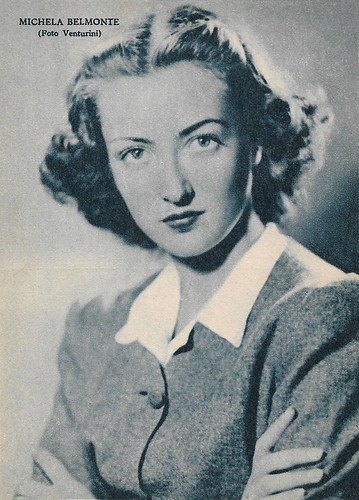
Italian postcard by Rizzoli & C., Milano, 1942. Photo: Venturini.
Italian actress Michela Belmonte (1925-1978) was the younger sister of actress Maria Denis. She was noticed by Roberto Rossellini who hired for a small part opposite Massimo Girotti in Un pilota ritorna (1942). Yet, this part was impressive enough for Mario Mattoli to let her play one of the protagonists of the film I 3 acquelotti/The 3 eagles (1942), next to Alberto Sordi, Carlo Minello, and Leonardo Cortese.

Italian postcard by Rizzoli & C., Milano, 1942. Photo: Pesce.
Anita Farra (1905–1979) was an Italian actress and scriptwriter, who also worked in Spain.
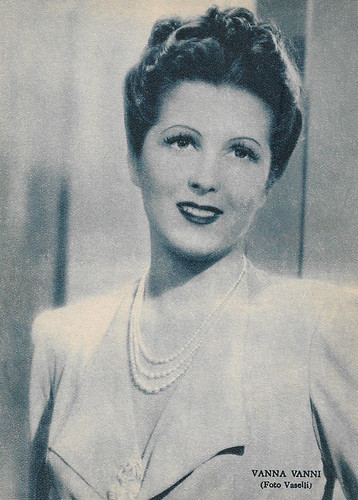
Italian postcard by Rizzoli & C., Milano, 1942. Photo: Vaselli.
The elegant brunette Vanna Vanni (1920-1998) was an Italian film actress who peaked in the late 1930s and early 1940s. She mostly played in comedies, many directed by Gennaro Righelli, plus several with the De Filippo family.

Italian postcard by Rizzoli & C., Milano, 1942. Photo: Venturini.
Blonde Italian film actress Mariella Lotti (1921–2006) played leading ladies in a number of Fascist-era and post-war films. The refined beauty quickly became one of the most popular Italian divas of the 1940s.
Sources: Wikipedia (English and Italian) and IMDb.
Also check out Part 1, Part 2, Part 3, Part 4, and Part 5.

Italian postcard by Rizzoli & C., Milano, 1941. Photo: Venturini.
Isa Miranda (1905–1982) was the only international film star produced by the Italian fascist cinema. In Hollywood, she was billed as the ‘Italian Marlene Dietrich’ and played femme fatale roles. Later she became one of the most significant European film actresses during the 1940s and early 1950s. Among her films were Senza cielo/Without the Sky (Alfredo Guarini, 1940) opposite Fosco Giachetti, and Malombra (Mario Soldati, 1942) with Andrea Checchi.

Italian postcard by Rizzoli & C. Milano, 1941. Photo: Ufa.
German actress Carola Höhn (1910-2005) had a 60 years lasting film career. She began as the elegant star of many Ufa productions and later became the acclaimed Grande Dame of the German post-war cinema. In 1941 Höhn starred in the Italian period piece Beatrice Cenci (Guido Brignone, 1941).

Italian postcard by Rizzoli & C., Milano, 1941. Photo: Ufa.
Dutch-born actress and singer Ilse Werner (1921-2005) was one of the most popular stars of the German screen during the Nazi years. She had her breakthrough with Wunschkonzert (Eduard von Borsody, 1940). Werner confirmed her reputation and popularity with the Jenny Lind biopic Die schwedische Nachtigall (Peter Paul Brauer, 1941). Her nickname, 'Ein Frau mit Pfiff', translates as 'A Woman of Distinction', but also refers to her trademark, whistling. After the war, she became a successful Schlager singer.

Italian postcard by Rizzoli & C., Milano, 1941. Photo: Vaselli.
Italian actress Paola Veneroni (1922) debuted as the spying pupil in Vittorio De Sica's Maddalena, zero in condotta (1940), starring Carla Del Poggio. Although it was her first film part, she immediately made an impact. With Del Poggio and Nina Paoli, she was the protagonist of Signorinette (Luigi Zampa, 1942), on three girls of 15-16 years old. After this film, she mostly played supporting parts.
The turning point during the war
After the Italians had been driven out of Egypt and the Eastern part of Libya, a large Germany army led by Erwin Rommel, the Afrika Korps, came the Italians to aid in early 1941, the start of the German African Campaign.
On the Balkan, Germany and Italy invaded Yugoslavia in April 1941 and struck a new battle with Greece, conquering the Greek mainland by the end of April, and Crete in May 1941. Italy gained southern Slovenia, Dalmatia, Montenegro and established the puppet states of Croatia and Hellenic State.
However, by 1942 the Italian economy was drastically going down, while Italian cities were being bombed by the Allies. Also, the African campaign was worsening – decisive defeat came with the Battle of El Alamein (October-November 1942).
It coincided with the French Invasion in North Africa and the Battle of Stalingrad. By January 1943 half of the Italian forces fighting in the Soviet Union were killed, the Balkan remained unstable, and Italians wanted to end the war.
In May 1943 the German and Italian forces in Africa would capitulate and in July 1943 the Allied forces would land in Sicily.

Italian postcard by Rizzoli & C., Milano, 1941. Photo: Venturini. Altieri's last name is misspelled on this card.
Italian film and stage actress Elena Altieri (1916–1997) appeared in 27 films between 1937 and 1955 and was mainly cast, both on stage and in films, in roles of haughty and aristocratic women. Altieri had major parts as 'the other woman' in Il pozzo dei miracoli (Gennaro Righelli, 1941) with Vivi Gioi and Antonio Centa, and Colpo di timone (Gennaro Righelli, 1942) with Gino Cervi and Dina Sassoli.

Italian postcard by Rizzoli & C., Milano, 1941. Photo: Venturini.
Italian actress Laura Nucci (1913-1994) was one of the stars of Italian cinema of the 1930s and 1940s. She also starred in the adventure film Fra' Diavolo/The Adventures of Fra Diavolo (Luigi Zampa, 1942) opposite Enzo Fiermonte. During the German occupation of Rome in 1943-1944, Laura Nucci became a close friend of Erich Priebke, the captain of the Gestapo. Between 1930 and 1989, she appeared in more than 60 films and TV series.

Italian postcard by Rizzoli & C., Milano, 1941. Photo: Venturini.
The elegant brunette Vanna Vanni (1920-1998) was an Italian film actress who peaked in the late 1930s and early 1940s. She mostly played in comedies, many directed by Gennaro Righelli, plus several with the De Filippo family. Occasionally she also acted in dramas such as Amiamoci così (Giorgio SImonelli, 1940) with Andrea Checchi.

Italian postcard by Rizzoli & C., Milano, 1941. Photo: Cie Française Cinem.
French actress and opera singer Renée Saint-Cyr (1907-2004) starred in more than 30 comedies and romantic dramas between 1932 and 1943. In 1940 she went to Italy to play opposite Vittorio De Sica in his own film Rose scarlatte (Vittorio De Sica, 1940), based on a play by Aldo de Benedetti. The photo on this card may stem from that experience. After the war the alluring beauty continued her film career in supporting roles, usually playing chic ladies.
A remarkable success
Despite the war and all the obstacles that came with it, the Italian film industry was highly active in the years 1941-1942. It would only collapse in 1943-1944.
Of course, Italy, with the entering into the war, produced several propaganda films, in addition to the documentaries, shorts, and newsreels, also fiction films lauded the Italian war campaigns, resulting in films such as Bengasi (Augusto Genina, 1942), Gente dell'aria (Esodo Pratelli, 1943), and I tre aquilotti (Mario Mattoli, 1942, based on a script by Vittorio Mussolini), etc.
Notable for its documentary-like approach was the submarine film Uomini sul fondo (1941) by Francesco De Robertis, while Roberto Rossellini did a war trilogy in which he combined propaganda with an anti-spectacular approach which he would continue which after the war as well: La nave bianca (1941), Un pilota ritorna (1942) and L'uomo dalla croce (1943).
A remarkable success was the two-part, anti-communist dark melodrama Noi vivi/Addio Kira!/We the living (Goffredo Alessandrini, 1942), inspired by a novel by Ayn Rand, and starring Alida Valli, Rossano Brazzi, and Fosco Giachetti.
Preceding the postwar neorealist cinema (and Luchino Visconti’s 1943 milestone Ossessione) but also reminding of the late 1930s French Poetic Realism is the social drama Fari nella nebbia (Gianni Franciolini, 1942) with Fosco Giachetti, Luisa Ferida and Mariella Lotti.

Italian postcard by Rizzoli & C., Milano, 1942. Photo: Bragaglia.
María Mercader (1918-2011) was a Spanish actress who acted in Spanish and Italian films, largely between 1939 and 1952. She was the second wife of Vittorio De Sica and the mother of Christian and Manuel De Sica.

Italian postcard by Rizzoli & C., Milano, 1941. Photo: Tobis.
Swedish-born, German film actress Kristina Söderbaum (1912-2001) was considered the prototype of an Aryan woman during the Third Reich. The blonde, blue-eyed star played the lead in several Nazi propaganda films directed by her husband Veit Harlan. After the war, this would damage her career.

Italian postcard by Rizzoli & C., Milano, 1942. Photo: UFA.
Dutch-born actress and singer Ilse Werner (1921-2005) was one of the most popular stars of the German screen during the Nazi years. In 1942, she starred in the popular backstage musical Wir machen Musik/We're Making Music (Helmut Käutner, 1942) with Viktor de Kowa.

Italian postcard by Rizzoli & C., Milano, 1942. Photo: Pesce. Annette Bach in Il mercante di schiave/Merchant of Slaves (Duilio Coletti, 1942).
German actress Annette Bach moved to Italy after a small part in Jud Süss/Jew Süss (Veit Harlan, 1940). In 1942, she starred in the Italian films Labbra serrate/Lips tightened (Mario Mattoli, 1942) and Il mercante di schiave/Merchant of Slaves (Duilio Coletti, 1942).
Inner conflicts and psychology
During the early war years, a new generation of young actors and actresses debuted in Italian cinema, such as Carla Del Poggio, Irasema Dilian, Luisella Beghi, Lilia Silvi, Elsa Altieri, Paola Veneroni, and others, mostly acting in romantic dramas or light comedies.
Comedy remained a large share of the overall production. Also, Vittorio De Sica, who had been so popular in the Camerini comedies, now started to direct his own films, often with a stronger social comment.
In contrast to the comedies and the propaganda films stood a string of literary adaptations, in which the inner conflicts and psychology of the main characters were central, combined with elaborate settings.
In hindsight, initially, the pejorative term Calligraphism was attached to this, but from the sixties on these films were highly revaluated. Thus Mario Soldati directed Alida Valli in Piccolo mondo antico (1941) and Isa Miranda in Malombra (1942).
Other directors within his genre were Luigi Chiarini, Alberto Lattuada, Renato Castellani a.o. Camerini had its most successful example of 1941-1942 with his adaptation of Manzoni’s I promessi sposi/The Spirit and the Flesh (Mario Camerini, 1941), starring Gino Cervi, Dina Sassoli, and Enrico Glori.

Italian postcard by Rizzoli & C., Milano, 1942. Photo: Ghergo.
Germana Paolieri (1906-1998) was an Italian stage and screen actress. After the war, she also worked for radio and television. As an actress, she flourished between the early 1930s and 1981, while as film actress she peaked in the 1930s and early 1940s, but also the mid-1950s. She acted in La gerla di papà Martin (Mario Bonnard, 1940) with Ruggero Ruggeri, Se son matti non li vogliamo (Esodo Pratelli, 1941) again starring Ruggeri, and in particular in the historical melodrama Pia de' Tolomei (Esodo Pratelli, 1941) in which Paolieri played the title role. During the war years, she also had a supporting act as Lauretta in Veit Harlan’s extremely romantic film Immensee/Il perduto amore (1943), starring Carl Raddatz and Kristina Söderbaum.

Italian postcard by Rizzoli & C., Milano, 1942. Photo: Bragaglia.
Irasema Dilian/Eva Dilian (1924–1996) was one of the most popular Italian actresses of the 1940s. She graduated from Centro Sperimentale di Cinematografia in 1940 and made her film debut in Ecco la felicità/La Comédie du bonheur (Marcel L'Herbier, 1940). Noted by Vittorio De Sica, Dilian became one of the students in his popular film Maddalena... zero in condotta/Maddalena, Zero for Conduct (1940). Thanks to this role, she became the rich private schoolgirl par excellence of the Telefoni Bianchi films. A highlight was her role as the spoiled, snobbish merchant's daughter and failed poetess Lilli Passalacqua in Teresa Venerdì (1941), again under the direction of De Sica.

Italian postcard by Rizzoli & C., Milano, 1942. Photo: Ciolfi.
Luisella Beghi (1921-2006) often played the fresh, young, and naive girl in the late 1930s and early 1940s. in 1942, Beghi was the protagonist of the calligraphic film Via delle Cinque Lune/Street of the five moons (Luigi Chiarini, 1942). The film, based on a story by Matilde Serao, is considered the "brightest point of (her) career, with an extraordinarily measured and mature acting".

Italian postcard by Rizzoli & C., Milano, 1942. Photo: Luxardo.
Italian actress Luisa Garella (1913-?) was a popular star of the Italian cinema of the late 1930s and early 1940s. In 1941 she played Franca in a version of the comedy Scampolo (Nunzio Malasomma, 1941) with Lilia Silvi in the title role.
The undisputed editions of the Venice Mostra
Just like in 1940, the 1941 Venice film festival (Mostra internazionale d'arte cinematografica di Venezia) didn’t take place on the Lido but at two cinemas in town.
Despite a broad European jury, the awards only went to Italy and Germany. Germany sent 9 features plus many shorts, Italy 7 features and some 25 shorts. Still, films from all the Scandinavian countries could be seen, as well as several from 8 other countries.
The Coppa Mussolini for the best foreign film went to Ohm Krüger by Hans Steinhoff, starring Emil Jannings as Paul Kruger, while the Mussolini Cup for best Italian film went to Alessandro Blasetti’s La corona di ferro, starring Gino Cervi, Elisa Cegani, Massimo Girotti, and Luisa Ferida.
The Coppa Volpi was also distributed (in contrast to 1940), to Ermete Zacconi for Don Bonaparte (Flavio Calzavara) and to Luise Ullrich for Annelie (Josef von Báky). A medal for best direction went to G.W. Pabst for his film Komödianten (1941), starring Käthe Dorsch.
In 1942 the last Venice festival was held before the end of the war, again not at the Lido. While Germany showed 6 features and several shorts, Italy showed 9 features (including the two-part Noi vivi/Addio Kira!) plus several shorts, but this time also some 5 Spanish features were on the programme.
Again, the jury came from all over Europe, but like in 1941, all the awards went to Germany and Italy. The Coppa Mussolini for the best foreign film went to Der grosse König by Veit Harlan, with Otto Gebühr in the role of his lifetime, Frederick of Prussia (this time orating clear war propaganda speeches).
The Coppa Mussolini for best Italian film went to another propaganda film: Bengasi by Augusto Genina, starring Fosco Giachetti, who also won the Coppa Volpi for his performance. The film focused on the North Africa campaign. The Coppa Volpi for best actress went to Kristina Söderbaum in Die goldene Stadt, again by Veit Harlan, her husband. Söderbaum also had a major part in Der grosse König.
Just like the 1940 edition, afterward, many considered the 1941 and 1942 editions of the Venice Mostra as ‘undisputed’, as if not held.

Italian postcard by Rizzoli & C., Milano, 1942. Photo: Venturini.
Italian actress Michela Belmonte (1925-1978) was the younger sister of actress Maria Denis. She was noticed by Roberto Rossellini who hired for a small part opposite Massimo Girotti in Un pilota ritorna (1942). Yet, this part was impressive enough for Mario Mattoli to let her play one of the protagonists of the film I 3 acquelotti/The 3 eagles (1942), next to Alberto Sordi, Carlo Minello, and Leonardo Cortese.

Italian postcard by Rizzoli & C., Milano, 1942. Photo: Pesce.
Anita Farra (1905–1979) was an Italian actress and scriptwriter, who also worked in Spain.

Italian postcard by Rizzoli & C., Milano, 1942. Photo: Vaselli.
The elegant brunette Vanna Vanni (1920-1998) was an Italian film actress who peaked in the late 1930s and early 1940s. She mostly played in comedies, many directed by Gennaro Righelli, plus several with the De Filippo family.

Italian postcard by Rizzoli & C., Milano, 1942. Photo: Venturini.
Blonde Italian film actress Mariella Lotti (1921–2006) played leading ladies in a number of Fascist-era and post-war films. The refined beauty quickly became one of the most popular Italian divas of the 1940s.
Sources: Wikipedia (English and Italian) and IMDb.
Also check out Part 1, Part 2, Part 3, Part 4, and Part 5.
No comments:
Post a Comment